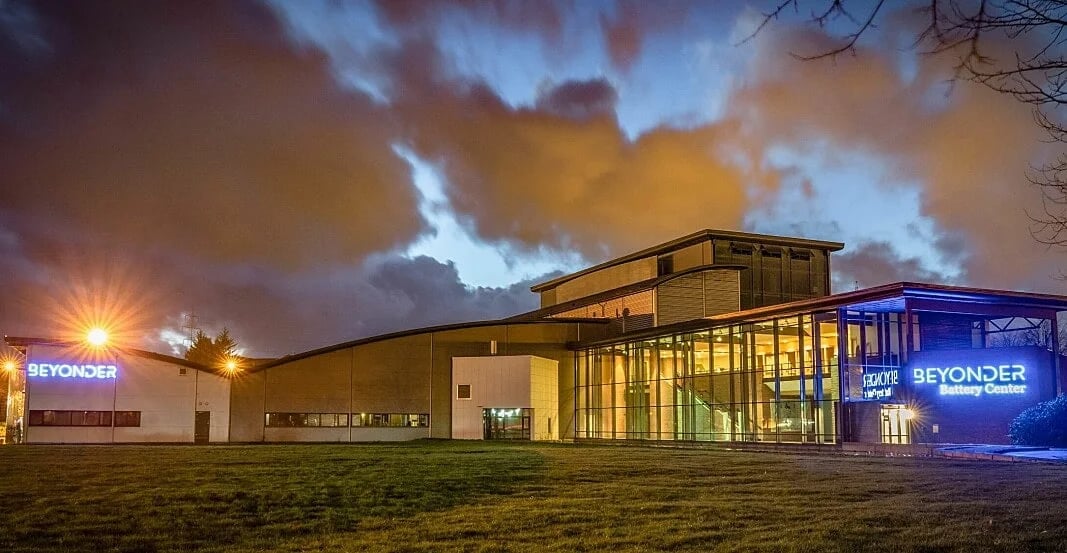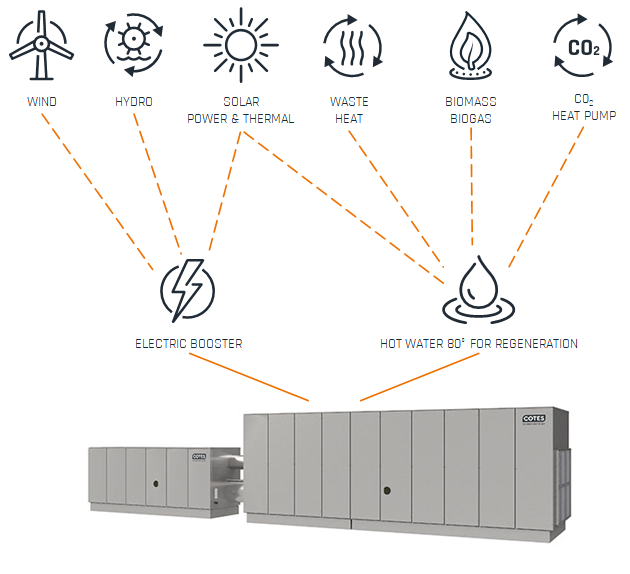This Beyonder case story is partially based on an article featured on Nemitek, in collaboration with F-Tech, our trusted Cotes Partner in Norway.
 Image: Beyonder facilities in Forus, just outside Stavanger, Norway.
Image: Beyonder facilities in Forus, just outside Stavanger, Norway.
The future of battery manufacturing is cheap and sustainable
In Norway, Beyonder is making the next generation, sustainable battery cell technology. Beyonder is an energy storage technology company creating eco-friendly and high-performance batteries for industrial use. The factory in Forus, just outside Stavanger, produces a carbon cathode that enables the Li-ion Capacitor (LiC) to operate at a higher specific power, with greater durability compared to conventional Li-ion batteries. However, working with Li-ion requires a dry room with extremely low dew points and extremely low levels of relative humidity. Maintaining these ultradry conditions requires a lot of energy. So, if batteries are to become truly sustainable, there needs to be a more energy-efficient and sustainable way to maintain dryness in the battery dry room.
When dry air needs to be ultradry
Apart from using new and more sustainable raw materials for battery production, Beyonder also needs to decarbonize the manufacturing process for the batteries they produce to be truly sustainable. When you work with Lithium in a production environment, a lot of energy is used to maintain dew points under -50°C (0,2% RH).
"If we do not have the right humidity, it is potentially hazardous to people’s health, flammable and product hazardous", states project manager Hjoar Falkeid from Beyonder.
For the dry production space in the prototype factory, the dew point requirement is -52°C. "These are extreme conditions", says project manager Stein Gerhard Johannessen from Caverion, who installed the Cotes Ultradry Dehumidifier at Beyonder.
The 165 square meter room is dimensioned for a given number of people, more than usual facilities as prototype production is done manually to test the new battery technology. A higher number of people means higher humidity.
"A person emits about 120 grams of moisture per hour. Putting one more person in the room can ruin the whole calculation", Johannessen points out.
The strict requirements also mean that it is extremely important to avoid air leaks in the room. All air must enter and leave the room via the dehumidifying solution.
Quality design meets enhanced functionality
Cotes Ultradry Dehumidifiers using the Cotes Exergic Technology have an innovative design and airflow that enable low temperatures for optimal performance and remove the risk of humidity contamination of airflows. The ultradry-air solution uses three rotors that dehumidify the air in three stages.
How it works
First, fresh air is dried in two stages, then it is mixed with a large proportion of recirculated air from the dry room before drying the air with the last rotor. When the air is dried out little by little, high temperatures are not necessary to remove moisture from the dehumidifier's rotors.
While other non-Cotes solutions require 130°C or more, Cotes Exergic Technology works with approx. 90°C to extract moisture from the silica rotors. The lower temperature makes it possible to choose a combination of sustainable heat sources. At the core of Cotes Exergic Technology, is the use of hot water to heat the air to 90°C. How you chose to heat the water is up to you, making it possible to choose from whatever range of sustainable energy sources are at your disposal. This enables huge savings in CO2 emissions related to running the dry rooms and in some European countries, we are seeing carbon reductions of up to 95%.
"If you need 130°C on the heating side, you must bring in a lot of electricity. At 90°C, you can use both district heating and heat pump", Johannessen points out.
The drying process also requires cooling before each silica rotor where the air is cooled down to approx. 10°C. This makes the adsorption rotors more efficient, so if you have a CO2 heat pump installed, you can utilise both heating and cooling, saving even more energy.

Using a combination of sustainable energy sources cuts carbon footprint and reduces OPEX
Beyonder's prototype factory uses a combination of electricity and district cooling (free cooling from the fjord). The choice of energy source is partly to get started as quickly as possible, but in the next phase, it may be relevant to combine district heating and district cooling.
"We have asked Caverion to be responsible for the solutions they believe are most cost-effective in operation without compromising on quality", says Falkeid.
Caverion's man, Johannessen, states that the dehumidifier solution has worked according to the conditions in prototype production: "The machines do their job and have completed the task with the 0.2% RH requirement. It's great".
The solution working well is also documented through particle counts in all clean rooms.
"We are well within the requirements of ISO 8 by a good margin, which was very satisfying to prove", comments Falkeid.
Highly favourable for CO2 heat pumps
Another alternative that is being considered is a CO2 heat pump.
"A heat pump combined with the Cotes dehumidifier is a good solution. Instead of using electricity for heating, you can use the electricity for a CO2 heat pump and get both cooling and heat", says Johannessen.
"When we utilize both the hot and cold side of the heat pump, the power saving factor becomes very high, up to six to eight", estimates project manager, Odd Olav Fosso from F-Tech, a trusted Cotes Partner in Norway for over 20 years.
"I believe Beyonder is operating the world’s most sustainable and energy-efficient battery dry room today", comments Thomas Rønnow, Business Development Manager and Owner of Cotes.
COTES SOLUTION
- Ultradry Adsorption Dehumidifiers with 2 rotors
- 1 intake + 1 main unit with dew point down to -50°C
- Supply dew point possible to go down to -52°C
- 6 persons in the dry room
- Heating resources: electricity and district cooling or heat pump
Jesper Lund Jørgensen, the Dehumidification Specialist for Cotes Exergic Technology, believes that this technology is a game-changer in the industry.
“At Cotes, we saw the opportunity to improve energy efficiency and optimal running conditions of dry room solutions”, explains Jørgensen. “What we have done with Cotes Exergic Technology is to go back to the basic principles of drying and use some clever engineering and design, combined with a mission to reduce energy and utilise as many alternative sustainable energy sources as possible — resulting in what is undeniably the most sustainable solution on the market."
In the case of Beyonder, the number of people in the dry room at any given time varies between one and six. The Exergic system supports a -52°C dew point with four people in the room using 90°C regeneration. Sometimes they need up to six people in the dry room at -52°C dew point, which requires the system to turn up the regeneration temperature to approx. 130°C.
Flexibility is built into the system because Exergic Technology works at lower optimal temperatures, making it possible to turn up the heat when needed. Other non-Cotes solutions are running at higher temperatures, leaving less surplus capacity to deal with extraordinary situations.
|
If you are a car or battery manufacturer that wants to go green(er) and save costs, then reach out to us. Cotes can help you find the right dry-air solution for your facilities and give you the competitive advantage of a more sustainable Li-ion battery. Contact Joris Vieux, Global Manager Battery & |

|
Are you curious about the potential energy savings for your battery dry rooms? Take a look at our free online calculator below.

.webp)